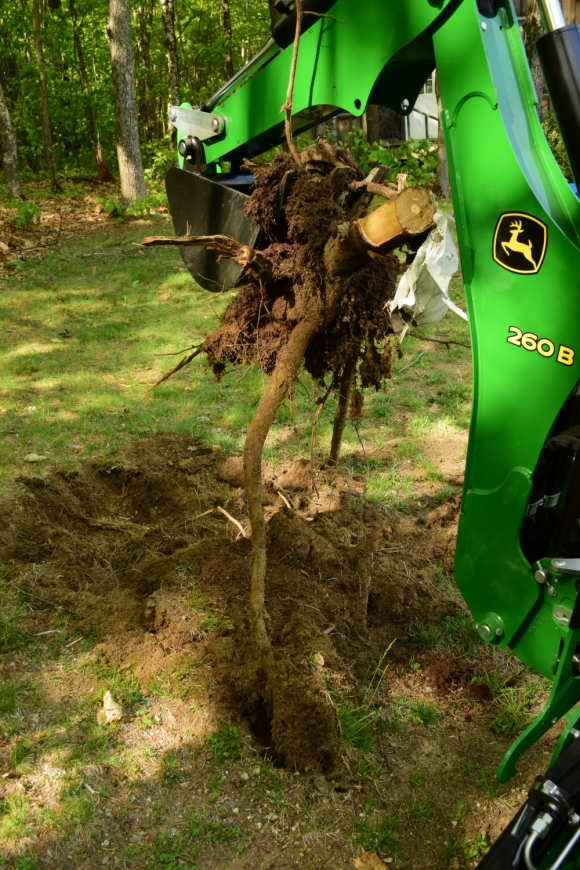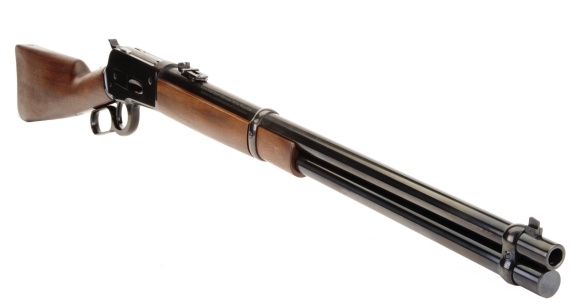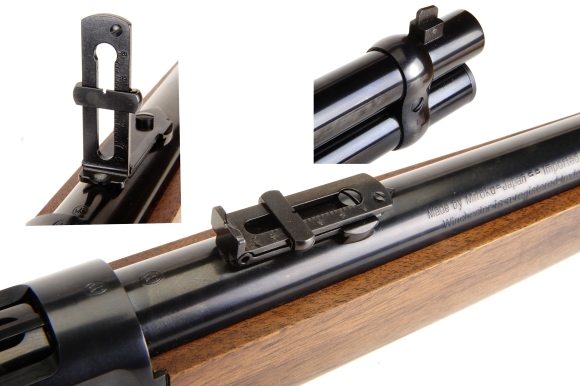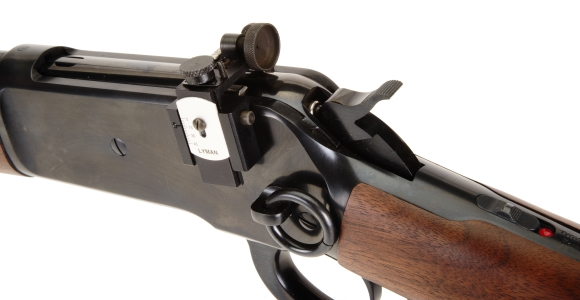05/29/2022 – As I get older, I spend more time working the property surrounding our home. Take today, as an example. I spent the morning cutting down some mature pear trees, a small oak and an elm tree to make way for a change in landscaping. Drought and cold resistant colorful ground cover, will replace a 7,200 sq.ft. sloping lawn adjacent to the driveway. That will remove a demand for 6,700 gallons of water per week when it doesn’t rain for weeks.
The afternoon was spent digging up stumps with a backhoe. Chomping away, snapping progressively deeper layers of roots until the stump could be wiggled out. More dentistry than forestry. I found all of that very satisfying, gratifying, and much more so than say… talking to people.
Around lunch time, I drove down the hill into town, about ten miles, to put gas in the car and fill a container with diesel for the tractor; $4.72/Gal for gas, $6.57/Gal for the tractor… $32.85 worth of fuel in a can. So I filled both, and sped back home to resume my communing with tree stumps. What does this have to do with Winchester rifles? Glad you asked.
More gun, no gunk…
|
Winchester Model 1886 |
|
| Manufacturer | B.C. Miroku |
| Item # | 534053142 |
| Type | Lever Action |
| Caliber | 45-70 Government |
| Mag Capacity | 7 |
| Barrel Length | 22″ |
| Rifling | 1:20″ |
| Weight | 8.0 Lbs |
| Overall Length | 41.0″ |
| Stocks | Oil Finish – Black Walnut |
| Hardware | Blued Steel |
| Length of Pull | 13.25″ |
| Drop at comb | 1.25″ |
| Drop at heel* | 2.00″ |
| Rear Sight | Adjustable Ladder |
| Front Sight | Blade |
| Drilled and Tapped | Receiver mounted sights |
| Trigger Pull | 4 Lbs. 7 Oz. |
| Safety | Tang – Sliding |
| MSRP | $1,549.99 |
I live in Maine. In my part of the woods, literal not metaphorical woods, I do not believe there is an unobstructed line of sight longer than fifty yards. However, when I drive down the hill during hunting season… to fill up with Biden priced fossil fuels, there are people walking the roadside with 26″ barrel bolt action rifles with astronomical telescope size optics.
Come to think of it, the same people wear camo that matches their respective gun stocks. The new Ford 3/4 ton trucks each exits has a crew cab, short bed, and electric motors at every axle. What they really needed was a Model 1886 and my… mature 4 wheel drive SUV.
So what is the Model 1886’s story?
John Browning’s Model 1886, for all of its 136 years of existence, has remained, visually, relative unchanged but over the years it has been extensively overhauled. The current version utilizes better alloy steel, it has a nicer and more durable finish, it is made with improved manufacturing processes, it is significantly more accurate, and the original half cock safety has been replaced with a rebounding hammer.
Wow! That was not a run on sentence. That was a lost its mind and skipped the country sentence. I will have to make a note of that.
From an application standpoint, the Winchester Model 1886 is as viable today as it was in 1886. In 45-70, it has more than enough power for Maine big game; black bear, deer and moose.
The Model 1886’s sight set is ideal for the hunting environment, it is built like a breech loading cannon and it holds plenty of big 45 caliber rounds. And, yes, it does look good.
The point is… and there is a point to make, the rifle is complete as it comes out of the box.You don’t have to shell out hard earned cash and then go accessory shopping before you can go hunting.
Historically speaking… writing
The Model 1886 was the third of three rifles John Browning was commissioned to design for Winchester, however, the 1882 and 1883 patented designs never went into production. The Model 1886 was manufactured between 1886 through 1935, Slightly modified, the Model 1886 became the Model 71 and remained in production through 1957. The revisions incorporated into the Model 71 were to accommodate feed and cycling of the 348 WCF cartridge and to introduce manufacturing process refinements and material improvements.
Strength

 The Model 1886 was designed from the beginning with big, high performance cartridges in mind: 38-70 WCF, 45-70, 45-90, 50 Express, etc. Subsequently, it has a stout design. Beyond the inherent strength of the thick walled steel receiver, the breech block has locating rails that ride in slots cut into the inside walls of the receiver. This arrangement holds the breech block square to the bore and allows only fore and aft movement.
The Model 1886 was designed from the beginning with big, high performance cartridges in mind: 38-70 WCF, 45-70, 45-90, 50 Express, etc. Subsequently, it has a stout design. Beyond the inherent strength of the thick walled steel receiver, the breech block has locating rails that ride in slots cut into the inside walls of the receiver. This arrangement holds the breech block square to the bore and allows only fore and aft movement.
In recent times, the Model 1886 and Model 71 have been available in L-R 348 WCF, 45-70 and 45-90. The 45-70 is more versatile than the 45-90. The 45-90 overall cartridge length limits bullet selection to lighter bullet weights and performance gains over the 45-70 with smokeless powder, rather than black powder, are negligible.
The 348 WCF is a terrific cartridge and the basis for some excellent wildcats. However, in standard configuration, the odd bore size limits bullet type and weight. In 450 Alaskan and 50 Alaskan, wildcats based on the 348 WCF, the Model 1886 or Model 71 can generate over 4,000 ft lbs of kinetic energy. Both cartridge designs from Harold Johnson, Coopers Landing, Alaska.
I sometimes see reference to people claiming to have visited Johnson’s gun shop in Alaska, but the only information I have seen regarding the gentleman’s occupation indicated he was a photographer, hunter and adventurer and, professionally, founder of Alaska Diesel Electric in Cooper’s Landing. In 1958, two years later he relocated the business to Anchorage. Which all leads me to believe Johnson was a firearm enthusiast, who designed the Alaskan series wildcats, but the actual firearms were built by several gunsmiths he commissioned and credits.
Appropriate sights
The current saddle ring carbines ship with a ladder type rear sight and blade type front. Folded down, for close ranges and flipped up for long range, the sights cover just about any circumstances within the range of the rifle. The rear sight has both coarse and fine elevation adjustment with windage compensation is adjusted by rear sight drifting. The front sight just sort of sits there, yelling, “Look at me! Look at me!”.
There are options
Turnbull Restorations makes a mount for open red dot sights utilizing the Winchester’s existing drilled and tapped holes in the receiver side. Both Lyman, pictured above, and Williams make terrific peep sights. They are micro adjustable for windage and elevation and both have interchangeable apertures and the option of target knobs so no tools are required for adjustment.
So far…
The Winchester Model 1886 is a well finessed version of the original. Real bluing, real walnut, well made. A tribute to Browning’s design. It is not a Rifleman twirling tiny carbine, but then “carbine” is a relative term. If the original had a 26″ or 28″ barrel, a 22″ barrel is a virtual snub nose.
At 8 Lbs, the Model 1886 is not a fly weight, but it also isn’t a heavy weight as it is complete as received, no scope to follow, and about right for the cartridge it chambers.
At $1,549.99 it is not exactly budget priced, but then it is not a budget kind of gun… if there still is such a thing. And it isn’t like a buyer will be getting multiples, as one would last a life time and survive being passed down to a younger generation. So amortized over years and years of use, perhaps it is a bargain.
What now? Don’t press me, I’m thinking…

| Cartridge | Bullet Type |
Bullet Weight Grains |
Rated FPS 24″ Barrel |
Recorded FPS 22.00″ Barrel |
Recorded FPS 19.00″ Barrel |
Recorded FPS 16.10″ Barrel |
3 Shot 50 Yard Groups |
| Winchester Supreme | FNSP | 300 | 1880 | 1777 |
1672 |
1531 |
1.3 |
| HSM A-Frame | FNSP | 350 | 2050 | 2238 |
2102 |
2141 |
1.0 |
| Buffalo Bore Magnum | FNJ | 350 | 2150 | 2234 |
2125 |
2116 |
1.4 |
| Remington Core-Lokt | SP | 405 | 1330 | 1083 |
1179 |
1022 |
1.6 |
| Buffalo Bore Magnum | LFN | 430 | 1925 | 1931 |
1904 |
1817 |
1.1 |
| Garrett Hammerhead | LFN | 540 | 1550 | – |
1528 |
1446 |
– |
We have been on a roll with 45-70 lever guns these days, As such we have standardized on test ammo in controlled factory lots. The Browning is represented on the table above in the 22″ barrel column and again in the 3 shot 50 yard group column. Groups were shot with the Lyman peep sight mounted with a 0.040″ target aperture.
I was perfectly happy with groups size. I could see the red bullseye clearly through the peep sight, not so much the bullet holes, so I wasn’t sure how I was doing until I pulled the targets.
Yes that is a “-” in the Hammerhead columns for velocity and 3 shot group. The Winchester Model 1886 has a very short leade. Yes, that “e” on the end of the word was intentional. It is the transition from groove to bore diameter and rifling just forward of the chamber.
The Garrett Hammerhead ammo at 540 grains has a bullet that holds its 0.458″ diameter close to the bullet tip. Subsequently, the bullet made contact with the Model 1886’s rifling before the lever was closed, preventing the round from chambering. See indentations in bullet pictured above.
Bullets should not contact rifling when a breech is closed as that can cause dangerously excessive start pressure. All of the other ammunition worked without a hitch. Keep in mind that Garrett Hammerhead ammo is not SAAMI spec ammo. The Winchester Model 1886 has a SAAMI spec chamber.
Shooting personality. Yes… I mean the rifle, not mine
The Winchester 1886 is well balanced. It does not feel heavy, even with a magazine full of ammo. It does feel very steady. Can’t complain about recoil and report as it is a 45 caliber cartridge with a good deal of punch.
The steel crescent shaped butt plate is not an issue with standard pressure ammunition, like the Remington and Winchester represented on the table. It does make its presence known with the modern high pressure ammo.
In the past, I have purchased a straight cut buttstock for approx $100, cut it down an inch and installed a nice cushy recoil pad. When I was done logging range or hunting time, I would just put the original stock back on. But, then, I am old and brittle. The reality is, standard SAAMI pressure 45-70 ammunition is more than enough for black bear, deer or moose.
For hunting and informal range work, I would either leave the ladder sight in place. If I got bored and needed to fiddle with the rifle. I would probably install the Lyman 0.093″ aperture, or leave the aperture out all together, effectively using it as a ghost sight. Despite the carbine’s 22″ barrel and 8 lb heft, it is a fast handling rifle.
Nice to know we can still purchase a traditional Winchester lever action rifle.








Email Notification